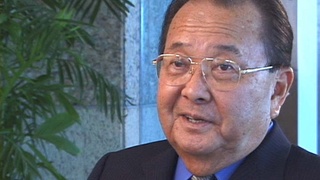Interviews
Wind in camp
Every day was the same old. I mean, a windy day, a dusty day, okay, go up to the camp, to the hospital and back. I mean, I don’t know. I just wondered, how long is this going to last. I just wanted to hurry up and go home. That was my thing. Hurry up and go home. Where it’s nice and clean, you know? Even in the camp, no matter how hard you tried to make the place clean, you get dust. Oh god, it was always dusty.
Yeah, terrible. I mean, you had to put a mask on you. Even your glasses, your mask, oh. When that wind blows, boy oh boy, it’s hard.
Date: May 24, 2011
Location: California, US
Interviewer: John Esaki
Contributed by: Watase Media Arts Center, Japanese American National Museum
Explore More Videos

Discharged from the U.S. Army after Pearl Harbor
(b. 1918) Founder Azumano Travel

Closing the Japanese school and deportation (Spanish)
(b. 1932-2016) Peruvian painter

Death of sister in October 1942
(1915 - 2011) Nisei florist who resettled in New York City after WW II. Active in Japanese American civil rights movement

Living conditions in prison while serving time for resisting the draft
(b. 1925) Draft resister

Talking to children about decision to resist the draft during World War II
(b. 1925) Draft resister

Reflecting on Japanese Americans' response to incarceration
(b. 1925) Draft resister

Encountering a train full of Japanese Americans being transported to a concentration camp
(b. 1923) Chick sexer


Sneaking out of the Hastings Park camp during World War II
(b. 1928) Doctor. Former Chair of the Japanese Canadian Redress Foundation.

Government's permission to publish Japanese newspaper in Canada during World War II
(b. 1928) Doctor. Former Chair of the Japanese Canadian Redress Foundation.

Government urged Japanese Canadians to go to Japan
(b. 1928) Doctor. Former Chair of the Japanese Canadian Redress Foundation.




